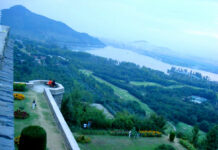Every time the governments in India and Pakistan resume diplomacy and wish to move forward on issues of mutual interest, non-state actors get it and push situations back to square one. This has emerged a sort of cycle that has never broken in last around three decades. The latest instance was Prime Minister Narendra Modi’s visit to Lahore that was a sort of a message that his government in Delhi is committed to what the foreign ministers had done a few weeks earlier. Then Pathankot took place and the Foreign Secretary level contact was delayed again.
The fact of the matter is that India as well as Pakistan is passing through a special situation. It started with the erstwhile USSR invasion of Afghanistan which initially led to militancy in Punjab and later in Kashmir. At both the places, the internal situation was ripe to adopt the new lingo of violence to communicate between the state and the subjects, or a section of it. Gradually, the violence became an industry and with world powers experimenting in the Hindukush Mountains, it became a much larger game that sucked the two countries into it.
Arab Spring and the subsequent developments that has now led to dreaded ISIS makes the situation totally complex for the entire region. This highly motivated wave has the capacity to overtake the diplomacy in both the countries even though the fact is that this region is neither supportive of ISIS kind of movement nor has the cadre-structure that can follow the peculiar savagery being packaged in the name of faith.
In such a situation, Delhi and Islamabad will have to rediscover its common interest and give a serious push to the love-hate relationship that they have exhibited for most of their history. There is no possibility of a grand geo-political alliance on SAARC pattern unless there are visible shifts in the way India and Pakistan see at each other. Though both the countries have strong issues in between – Kashmir being the most crucial, they still have a lot of commerce around to talk and negotiate about.
The recent crisis in Siachen glacier is just a pointer towards the inevitability of talking. Akin to the two bald men fighting over the comb, the Siachin crisis has been draining the resources of the two countries since 1984. The best and the honest strategic and defence experts in both the countries and across the world have repeatedly insisted that the vast glacier lacks any strategic importance. It’s only worth lies for the ecology and the science. At a time when the climate change is the main issue that humanity is confronted with, Siachen could offer a huge way-out of the crisis the two countries are living in. They have already negotiated it threadbare and at one point of time, they were about to sign the papers for withdrawal and protection of the glacier for the posteriority. Given the fact that the glacier falls in the territory of J&K, the state has a stake in its survival. Any climatic crisis on this glacier can trigger doom for a larger population.
J&K is perhaps the only state in India that has a direct stake in the peaceful coexistence of India and Pakistan. History has been demonstrated it countless times. In case the two countries come out of the diplomatic impasse, J&K can become a major window in helping the two countries trade better. If this can be sustained for some time, it will give enough of confidence to both the countries to settle the issue permanently.









